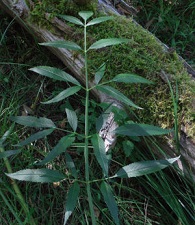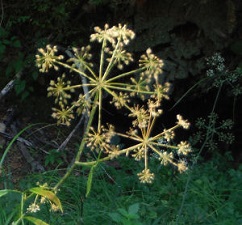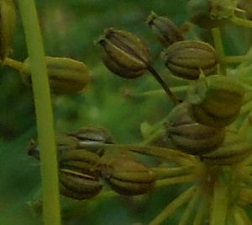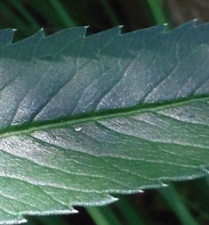



|
|
Practical ecological knowledge for the temperate reader. |
Family: APIACEAE - Carrot Family [E-flora]
Other Names: western water hemlock.[E-flora]
 |
 |
 |
 |
Synonyms
General: Stout perennial herb from a taproot or cluster of tuberous roots; stems solitary or few together from a tuberous-thickened and chambered base, leafy, glabrous, 0.5-2 m tall.[IFBC-E-flora]
Leaves: Basal and stem leaves divided 1-3 times, leaflets 3-4 times as long as broad, lanceolate to narrowly oblong or elliptic, these sharply pointed and toothed, 4-7 mm long; lateral veins ending at base of the teeth.[IFBC-E-flora]
Flowers: Inflorescence of several to many small, compact clusters forming several compound umbels; flowers white to greenish; involucral bracts mostly lacking.[IFBC-E-flora]
Fruits: Egg-shaped to orbicular, 2-4 mm long, glabrous, corky-thickened; ribs unequal, with a narrow raised border on edge of dark intervals.[IFBC-E-flora]
Plant 15–30 dm. Leaf: 1.5–4.5 dm, narrowly ovate to triangular-ovate, 1–2(3)-pinnate; leaflets 1–10(15) cm, linear to widely lanceolate, acute or acuminate, ± entire to coarsely serrate, areas surrounded by veins on abaxial surface rough-textured, generally some elongate. Inflorescence: umbels compound, terminal and lateral; peduncles 2–18 cm; rays 15–30(35), 2–8 cm; pedicels 20–30, 2–10 mm. Fruit: 2–4 mm, generally round; rib width >> intervals between.
2n=44. Wet places, generally aquatic; < 2800 m. North Coast, High North Coast Ranges, Inner North Coast Ranges, High Cascade Range, s Sierra Nevada Foothills, High Sierra Nevada, Central Coast, South Coast, Great Basin Floristic Province; to British Columbia, Montana. Jun–Sep [Online Interchange][Jepson2012]
Habitat / Range
Wet stream edges, ditches and marshes in the lowland, steppe and montane zones; common throughout BC except the Queen Charlotte Islands; N to AK and S to ID, NV and CA. [IFBC-E-flora]
Origin Status: Native [E-flora]
Distribution & Habitat
Cicuta spp. are found growing across North America and Europe. Typically, they grow in wet habitats usually alongside ponds and streams, in marshes or swamps, or areas that are swampy at least part of the year. Plants can also be found growing in water.[2][3] Of the four species, Cicuta maculata has the most widespread distribution occurring across the majority of North America. Cicuta bulbifera also has a relatively large distribution, found throughout Northern North America. Cicuta douglasii is found in the northwest corner of North America, while Cicuta virosa is only found in central Europe and in the far north of North America.[1][3] [Wiki]
This plant (with its eastern relative) has gained the reputation of being the most poisonous plant in the North Temperate Zone. The poison is concentrated mostly in the lower part of the stems or roots. It often causes death to livestock, and it is sometimes stated that a piece the size of a walnut will cause the death of a cow. Human beings have sometimes been poisoned by water hemlock, eating the underground parts, having mistaken them for various edible roots like parsnips. Children will sometimes do this, often with fatal results. It is said that a piece the size of a marble can cause death to a man. The poison is very virulent and causes violent convulsions. Vomiting should be induced at once and a strong cathartic administered. [Harrington]
Identification: Though poison and water hemlock usually have roots with chambers, Daisy Lee Bitter of Homer, Alaska, has found young roots of C. mackenzieana (virosa) that lack pronounced separations in the roots. She comments that the pungent odor of the roots is the most diagnostic characteristic in recognizing Cicuta.[Schofield]
Bella Coola: Roots used as a purgative. [Smith(1927)]
This is one of the most poisonous plants
known to man. It contains cicutoxin, a violent convulsant acting directly on the central
nervous system (Claus and Tyler, 1967).
The Kwakiutl used it with caution as a
purgative and to induce vomiting (Boas,
1966). The Salish may also have had such
medicinal uses for it.[Turner&Bell1]
Young fir bark, burned, pulverized, and mixed with water in which waxwaxuli (Cicuta douglasii) had been rubbed, was taken for diarrhoea (Boas, 1966). [Turner&Bell2]]
To induce permanent sterility, writes Weiner in Earth Medicine, Earth Foods, Cherokees chewed hemlock root for four consecutive days. Rafinesque, a botanist of the 1700s, said that a similar remedy was taken by Indians ". . . tired of life and desiring a speedy demise." Historians generally believe Socrates was killed by a different but equally deadly hemlock, C. maculatum. Conium was also used by medieval herbalists "to keep maiden's teats small," and to destroy lust. As an external application, it was once used for rheumatic pain.[Schofield]
Throughout the ages, hemlocks of various species have been used to execute both criminals and kings. Oregon Indians soaked arrows in Cicuta juice, rattlesnake venom, and decayed deer liver to poison tips for hunting. [Schofield]
Cicuta douglasii (DC.) Coult.+Rose
Family: Apiaceae
Seed and Pericarp
Mass of 1,000, g: 3.9
Oil, % dry wt: 16.9
FAs
Composition (GLC, Ag+ TLC), %: 16:0 – 4.6;
18:0 – 1.1; 18:1(6) – 39.3; 18:1(9) – 14.8; 18:2 –
39.5; 18:3 – 0.7 [LEO,2012]
"Habit: Perennial herb, glabrous; rhizome internally chambered, sap becoming +- red-brown in air, fibrous- or tuberous-rooted. Stem: erect, hollow. Leaf: blade oblong to triangular-ovate, 1--3-pinnate or ternate-pinnate, leaflets linear to lance-ovate, serrate or irregularly cut. Inflorescence: umbels compound; bracts generally 0; bractlets generally inconspicuous; rays, pedicels many, spreading. Flower: calyx lobes minute; petals wide, white, tips narrowed. Fruit: ovoid to spheric, +- compressed side-to-side; ribs low, corky, occasionally unequally spaced; oil tube 1 per rib-interval; fruit axis divided to base. Seed: face flat or concave.
Species In Genus: +- 4 species: Eurasia, North America. Etymology: (Ancient Latin name) Toxicity: TOXIC: the most lethally toxic native plant species." [Jepson]
Local Species;
Other, Non-local, B.C. Species